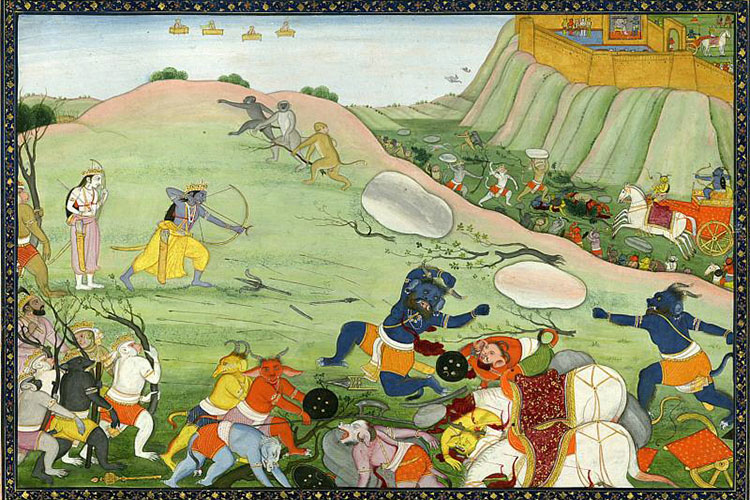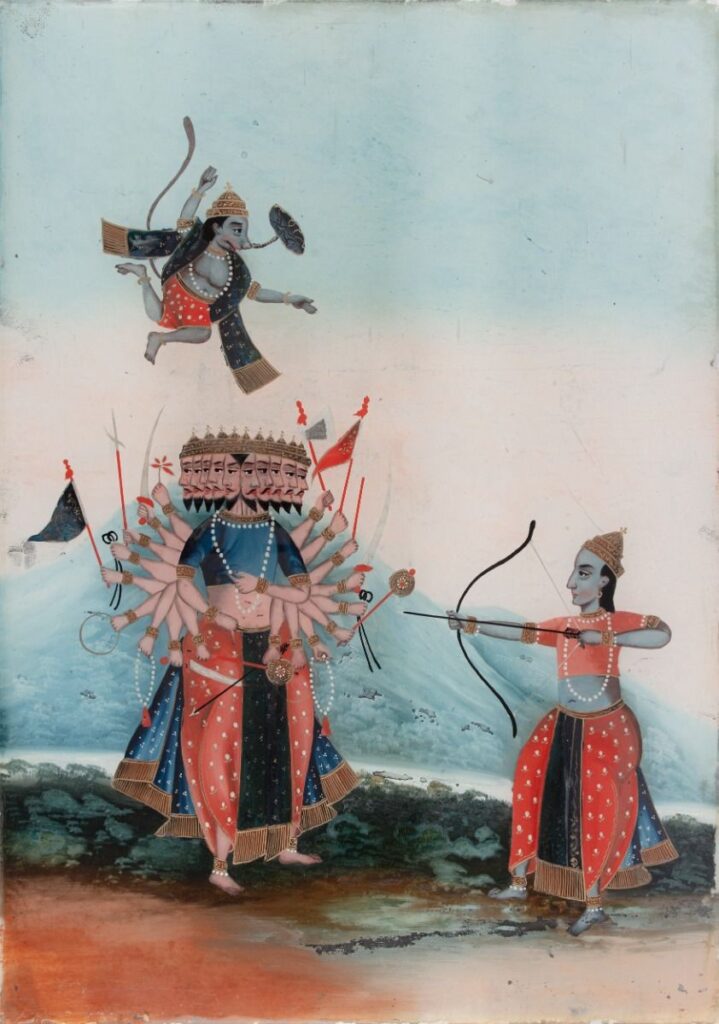Autumn 2025 Ramayana
Practical Yoga Mythology and Philosophy - the Rāmāyaṇa
Itihāsa course - 12 hours on the Rāmāyaṇa
Course fee
- 240 CHF- ( Bank Transfer only)
Dates: September 15 - November 5th
- Mondays in English (online)
- Wednesdays in French (online)
- 18:30-20:00 Vevey time
Description
You don’t need to be an āsana practitioner or meditator to join this course!
These teachings are about the whole of our lives.
However, if you do work with āsana and other yoga techniques, this course will help support and deepen that practice. The Rāmāyaṇa – the adventure of Rāma – encodes the path of yoga practice and the journey of a human life.
With live storytelling and time to unpack the practical riches the stories contain, experience the beauty, relevance and robust support of the Rāmāyaṇa.
Our series will include stories of
– Rāma’s teachers, Vasiṣṭha and Viśvāmitra – what it takes to become our own friend and the realities of the path of practice towards deeper self-knowledge and understanding. The role of ‘the guru’ and the principle of the guru in yoga practice
– Rāma’s ancestors, including Bhagiratha and the descent of Gaṅgā
– The churning of the milky ocean and the ongoing play of seemingly opposed forces
– The ‘main story’ of Rāmāyaṇa during which we’ll learn about the great characters Sītā, Hanuman, Lakṣmaṇa, Rāvaṇa and his brothers and gain a map for the perennial terrain of the journey of life and practice.
These days, mainstream school often teaches people to ’tick the right box’, as if that’s how one gets on in life.
Mainstream media channels often spin their so called reporting so it fits into the groupthink box their organisation adheres to.
But the reality is that life doesn’t fit into neat boxes.
Your right livelihood, the authentic expression of you – that doesn’t fit into a box.
- You are a unique human being.
- You are a unique expression of the infinite creative capacity of consciousness.
- You are a unique child of god/existence/life.
- And life just doesn’t fit into boxes.
The seers of the yoga tradition recognised this.
Yoga does not offer us reductive rules or a black/white binary perspective. Yoga is far too wise for that.
Its robust principles were proven in the furnace of time before they were set down in the classic yoga texts.
We have access to these practical, time-proven teachings in mutually supportive forms, for example:
The ultra pared-down Yoga Sūtra – the stitches to weave together the fabric of unity
The inquiry, the dialogue, the searching conversation of the Bhagavad Gītā that invites us to transform the cacophany of the battlefield into the harmony of a dancefloor – to work with the seeming pairs of opposites to draw forth their complementary potential.
And the compelling, archetypal stories, such as Rāmāyaṇa, that convey these teachings at so many levels:
Itihāsa – so it happened, so it happens
These stories unfold in the ever new now.
Communicating on multiple levels, they invite us into real yogic learning – to fathom greater depths of our psyche, look in ways that reach beyond our habitual ways of looking and remember more of who we are.

This autumn:
- Practical Yoga Mythology and Philosophy – the Rāmāyaṇa
- Itihāsa course – 12 hours on the Rāmāyaṇa
- Mondays and Wednesdays online in English and French
- 18:30-20:00 Vevey time
- £240
Autumn 2025 Rāmāyaṇa course
Dates for the 8 sessions
Mondays and Wednesdays 6:30-8:00pm Vevey time
English classes
- Monday Sept 15
- Thursday Sept 25
- Monday Sept 29
- Monday Oct 6
- Monday Oct 13
- Monday Oct 20
- Monday Oct 27
- Monday Nov 3
French classes
- Wednesday Sept 17
- Wednesday Sept 24
- Wednesday Oct 1
- Wednesday Oct 8
- Wednesday Oct 15
- Wednesday Oct 22
- Wednesday Oct 29
- Wednesday Nov 5
All participants have access to all recordings and course materials for the duration of the series and through until September 2026 and can attend both English and French sessions if desired.

8 session series on Rāmāyaṇa
Propective overview – subject to change depending on the group.
1. Introduction:
Rāmāyaṇa – the ayana – ‘going’, quest, journey, adventure of Rāma
Itihāsa – so it happened/so it happens – history, epic, archetype, storytelling and yogic literature
The story of story, the power of story.
Cosmic back story and key players:
The Ikṣvāku/ Sūryavaṁśa lineage, childless Daśaratha’ yajña for progeny and the gods’ pleas for help to end Rāvaṇa’s tyranny.
Many Rāmāyaṇa-s.
Vālmīki and how the story came to be.
The Vālmīki Rāmāyaṇa as frame and how we’ll explore it.
Bālakāṇḍa – Rāma as embodiment of dharma and how the story is then set up as a manual for dharma…
Rāma and brothers’ birth, tutelage with Vasiṣṭha
The arrival of Viśvāmitra
Daśaratha’s reception, solicitation, refusal
Viśvāmitra’s disgust, Vasiṣṭha’s intervention and Daśaratha’s change.
Unpacking of this episode including initial background to story of Viśvāmitra/Kauśika and Vasiṣṭha, the Gāyatrī Mantra.
Rāma and Lakṣmaṇa on mission with Viśvāmitra, killing of Tāṭaka and Subāhu, throwing of Mārīca.
-On the need for/role of a guru
2.Rāma before Sītā – after initial tutelage with Vasiṣṭha – now on mission. Story of Viśvāmitra and Vasiṣṭha.
Story of Rāma’s ancestors: Raghuvaṁśa – Sāgar, Dilīpa, Bhagiratha, Gaṅgā
3.Rāmāyaṇa as emblematic of whole play of existence/course of practice/adventure of life.
Churning of ocean of milk and classic purāṇa-ic motifs.
4.The tournament, Sītā, marriages, the deputation of Bharata, Daśaratha’s decision to coronate Rāma.
Manthara and Kaikeyi
Daśaratha’s collapse – (weakness of indriyāḥ without their true source, demonstration of what happens when a king is ruled by sensual desire rather than kingly duty – both in his making the bad promise and in his collapse in front of his favourite wife.)
Rāma’s yogic response, magnanimity.
Sītā and Lakṣmaṇa response
Into the forest, the townspeople pursue.
Bharata’s return, indignation, pursuit of Rāma. Lakṣmaṇa’s alarm, Rāma’s calm. Bharata’s petition, the sandals. Nandigrāma.
Further into the forest. Life in the forest
Śūrpanakha, Rāvaṇa’s interest in Sitā, decimation of Rākṣasa raiding parties. The golden deer. The kidnap. Jātayu.
Rāma’s despair. The search. Meeting Hanuman and Sugrīva. Alliance with Sugrīva. Slaying and death of Vālin, Aṅgada made crown prince.
The rains. Sugrīva’s indulgence. Lakṃaṇa’s intervention.
The search.
Hanuman, Vāli, Sugrīva and vānara-s backstory.
Standing at the edge of the ocean
5.Sundara Kāṇḍa – Hanuman’s leap and unpacking.
Sītā, Hanuman’s mission continues, return to Rāma.
6.Crossing the ocean, the bridge, the war. Āditya Hṛdayam.
7.Unpacking the war, the three brothers: Rāvaṇa, Kumbhakarna and Vibhīṣaṇa.
Indrajit, Rāvaṇi, Meghanāda
Hanuman and the Himālaya, Hanuman as guru, Hanuman as servant.
The return and the Triumph of Light, link to Diwali and previous conquests of asura-ic forces
8.Uttara Kāṇḍa – Sītā’s banishment, Lakṣmaṇa’s end. Rāma’s sacrifice. Rāma hearing the Rāmāyaṇa.
Sītā, Lava and Kuśa – how they came to be.
The questions on dharma.
Story intended to keep us inquiring, not to give us a definitive answer.
The story as the teachings of yoga in story form.
The eight limbs in the story.
The story as the living expression of the teachings.
Working with the story in practice.
Hanuman
Sītā
Lakṣmaṇa
